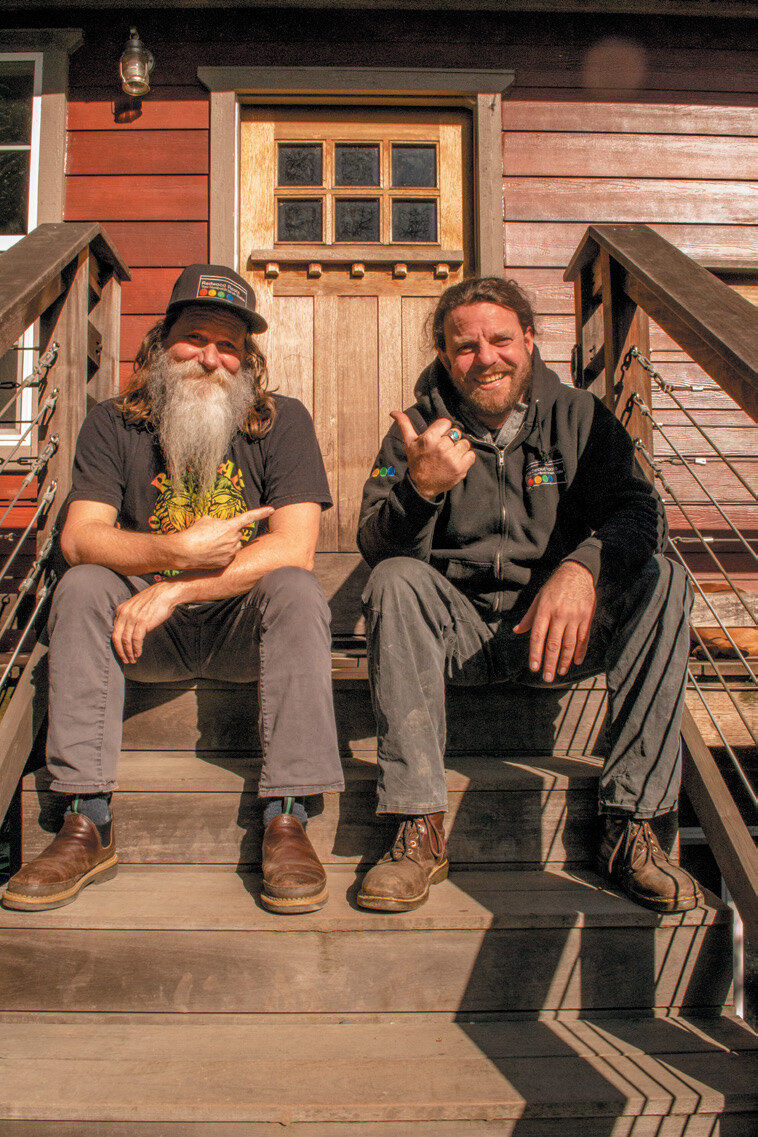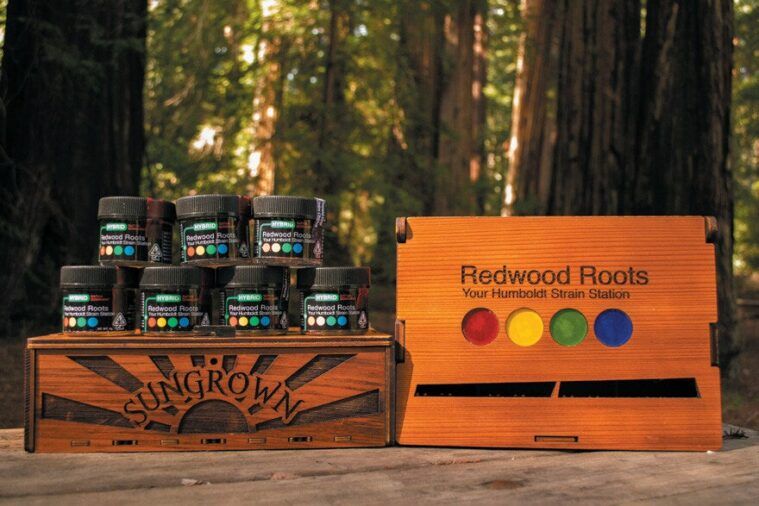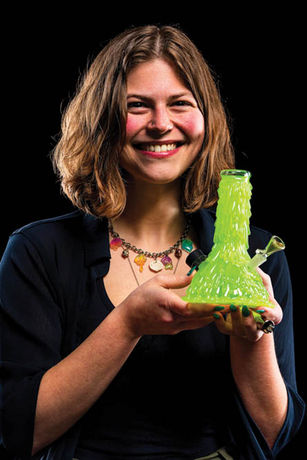The Humboldt fog rolls like smoke through the valley below, a ghostly river bathed in the rising morning light.
Chris Anderson surveys the mist as it snakes through the redwoods that blanket the valley, and gestures to King Peak in the distance, where authorities raided a grow he was working on back when he was 19. He’s at turns animated and withdrawn – a storyteller who gets lost in thought as the sun rises over the rolling hills.
“We need to work together to survive and thrive,” Anderson says. “We need to drop our egos and come together to build something truly magnificent.”
Now 45, Anderson comes up here to the switchbacks over Garberville every morning to catch the sunrise over his hometown in the heart of Southern Humboldt. Here, he sets his intentions for the day, reflecting on the past, present and future of his community.
It’s a region with deep roots and a storied history, providing Anderson with a life rich in adversity and success. Now it’s his turn to give back.

Growing the network
I first met Anderson at Emerald Cup in December 2019, as he and his company, Redwood Roots, celebrated significant wins in the festival’s competition. His farm partners took home eight of the top 10 in the flower category, and the positivity was so palpable it practically occupied physical space.
Within moments of shaking Anderson’s hand, he pulled me into a photo op with his squad, all kitted out in Redwood Roots hoodies and hats, before inviting me and a colleague into his booth to look through Scott Holmquist’s legendary homage to the history of Humboldt Cannabis – “Chronic Freedom.”
It was mere moments after we met, and here he was, drawing us in, sharing intimate stories of friends who had passed – either by murder or suicide – in the hard-fought battle for the soul of the Emerald Triangle.
Fast forward to February. Anderson has farm samples splayed out on the table before him in his team’s office, in a converted home on the southern edge of Garberville. He and his operations wizard, Roger Harrell – an OG snowboarder with a Gandalf beard whose official title with the company is Swiss Army Man – are entertaining a stream of calls and visits from cultivators. Anderson agrees to move weight for two new farms that afternoon.
“We’ll sell herb for one farmer,” Anderson said, “and in a couple of days, we’ll hear from their neighbor, saying, ‘Hey, we heard you moved their herb and they got paid right away. Can we work together?’”
The way Anderson sees it, this is the way things should work in Humboldt. Small farmers should join forces to stave off the tide of outside money pouring into the California market.
After all, Humboldt has a legacy to protect. The county claims 33% of the cultivation licenses in California. Southern Humboldt is home to 65% of those licenses. That means that roughly 20% of the cultivation from what may be the largest Cannabis market in the world comes from the area surrounding Garberville.
“They’re the people who actually sacrificed their livelihood and spent time in prison to make this happen,” Anderson said. “First thing’s first. Let’s just take care of our people. (Consumers) are starting to see through all the plastic bullshit. ‘Oh, we’re all about the small farmer.’ Fuck you. No, you’re not. You can’t replicate this. You can’t fake this. … This is our story and we should be able to tell it.”

Cultivating a communal company
As of this writing, Anderson said that his company has distributed for upwards of 80 farms, many of which carry the Redwood Roots label on their flower.
“We want to be the best first-mile distributor known to man,” he said of the business model. Redwood Roots aggregates and manages the farm relationships on the cultivation side, and then delivers the product to the regional third-party distributors all over the state, who will then disseminate the packaged product to retailers.
According to Anderson, his team currently moves a minimum of a couple thousand pounds of Cannabis flower and material per month. The entire concept allows farmers to focus on what they do best – cultivating stellar sungrown Cannabis.
“Anything that can help the little guy survive,” Anderson said.
Listening to him talk, he feels a little like William Wallace uniting the Scottish clans against the English. It’s almost as if Anderson, Herrell and their crew view themselves as protectors, responsible for the well-being of those they represent. It’s their family against a new world that doesn’t necessarily have the community’s best interests at heart.
“They asked all of us to come out, stick our necks out, and get licensed,” said Harrell, talking about Prop 64 and the regulated recreational market. “Then, before you know it, they change a regulation, and all of the little guys who stuck their necks out are gone, and new, big guys come in.”
This aspect of the Cannabis community, particularly in California, forces companies to craft what Anderson and Harrell call ‘sandcastle business plans,’ where nothing can be built to last.
“You build it, and then the wave comes and knocks it over,” Anderson said, referring to the constantly shifting landscape facing business owners from a regulatory and competitive standpoint. “Cannabis isn’t a new industry, but the regulated industry is brand fucking new.”
According to Anderson, the only thing you can rely on in a constantly shifting environment is the strength of the relationships you forge.
“It’s gonna take time when you’re going against these companies that have 200 million dollars to blow,” he said. “Money and flash don’t equal relationships. … This is a fire drill for us. We have to be smart and learn to compete with these fucks.”
The Redwood family tries to stay creative, focusing on guerilla marketing tactics and expanding its network of legit Humboldt farmers and statewide distributors and retailers. It’s not going to be easy.
“Marketing is a science, and it’s very developed right now,” he said. “My strategy is to co-brand with the farmers. It will be a lot easier to grab that shelf space as Redwood Roots.”
The goal is to build the Redwood Roots family into a brand that stands the test of time – if the rising tide lifts all ships, Anderson and his team want to be the water. Anderson wants to help usher in an economic resurgence in the area and help build a robust Cannabis tourism economy by marketing to young outdoors enthusiasts.
“As the market kind of opens up and becomes a microbrewery, winery-style environment, we can start building up the individual brands. Eventually, the farm will get the real estate on the label,” he said – and Redwood Roots will simply be an insignia in the corner.

Staying true to the community
Talking over breakfast at Woodrose Cafe on Garberville’s main drag, it seems like every person who walks through the door knows Anderson. At least half of them walk over to say hello and to give him a hug. It’s a true small-town vibe.
Anderson was born in Arcata and raised in Garberville, where he has lived for his entire life. His parents, Steve and Kathy Anderson, owned Trees Restaurant in town.
“Everybody knows every little fragment of my business,” he said.
Inspired by the culture and books like Jack Herer’s “The Emperor Wears No Clothes,” Anderson started cultivating Cannabis at age 16, unbeknownst to his parents.
“I was definitely enamored by that lifestyle,” he said. “I always believed in the medicine.”
Driving around Garberville, Anderson switches gears from long-time Cannabis hustler to wistful historian.
“My first girlfriend lived in that house,” he says as we pass by a neighborhood bungalow. “We played soccer on that field,” he said, passing by the school.
His pride for his community runs deep. Passing by the Mateel Community Center, where the Reggae on the River Festival was first held before outgrowing the venue and moving farther down the banks of Eel River, he discusses the past, present and future of Garberville.
“This region has always been an extraction economy,” he said. “Money and resources have always been extracted from this region. There has always been a CEO somewhere else that has collected.”
Rather than extract, Anderson and Redwood Roots plan to cultivate and propagate.
“There’s only one place in the world that has all these Redwoods, and a history of Cannabis going back 60 years,” he said. “Pot needs to be extracted, but we want the money to stay here.”
Roots of the industry
It’s sunset, and Anderson soaks in the golden glow as his dog, Kenya, mingles with the canine residents at Lady Sativa Farms, which sits perched high on a hillside overlooking the valley.
“From here you can see Alpenglow Farms, right over there,” said Rio Anderson, who owns and operates the farm, pointing to a neighboring hilltop. Rio and Chris aren’t related, but they’re family. Redwood represents Lady Sativa in the market.
Panning across the horizon, it becomes apparent that just about everywhere you look, there’s likely a Cannabis farm tucked in among the Redwoods. Even if you don’t know they’re there, they’re there – and they have been for generations. The community roots run strong and deep here.
“Knowing the importance of leaning in and growing together is a no-brainer,” Chris Anderson said. “This is a marathon, and we want to be here until the end of the race. … This journey is not for the faint of heart. Each little hurdle you jump should be celebrated.”










